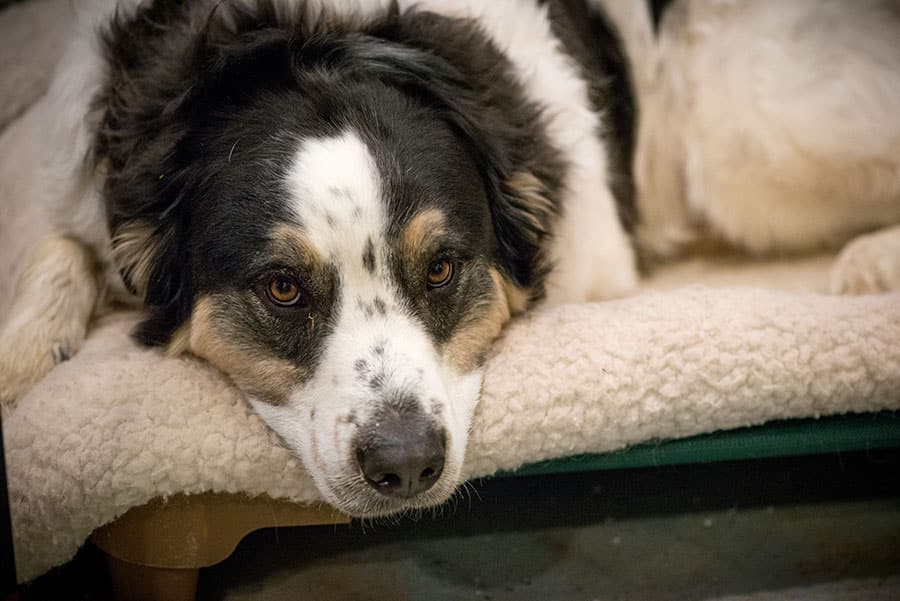Fear and Its Role In Training
We’ve had several fearful dogs in for training recently. Often, they are behaving aggressively, either towards other dogs or towards people, in an attempt to increase their social distance from strangers or unknown dogs. It’s a troubling topic for owners who aren’t sure how to respond to help their dogs, dogs who are loving at home but very troubled out in the rest of the world. Their noisy outbursts of barking, growling, chasing other animals, and sometimes even biting are embarrassing and worrisome for their pet parents.
What causes a dog to be fearful? All behavior is a combination of genetics and environmental history. But with fear especially, there appears to be a strong genetic component to this behavior. We recently trained a young dog that was extremely fearful of new people, places, and dogs. She could be quite scary with her growling and barking and had already bitten two visitors into the owner’s home. We learned her entire litter had been dropped off at a local shelter as puppies. By one year of age, three of the pups had been returned due to aggression. One had already been euthanized, another was in the shelter’s training program but things were not looking good for him, and the shelter staff was afraid he might not ever be able to be adopted out again.
In addition to their skittish genetics, these pups had clearly missed out on socialization during their first months of life. Their behavior indicated a lack of exposure to people and other dogs during their key socialization window which is open until between 16-20 weeks of age. Our client was committed to doing everything she could to help her pup have a better life.
Rehabilitating & Training Fearful Dogs
Rehabilitating fearful dogs is tricky and takes time. When this pup arrived at our training center at a year old, she showed off all the reasons she was there. Lunging and barking at me and keeping her distance. In order to safely work with her, I instructed her owner to place a muzzle on her, along with a long leash. Over the next few hours, I spent time teaching her to follow me, building her trust, and just sitting with her, becoming her friend.
By the next day, she was ready to be introduced to the pack. Our pack consists of our two, intact male German Shepherds, and a small neutered, male Wheaton Terrier Mix. All three are completely friendly and very good at coaching other dogs in normal dog interactions. The German Shepherds play the role of pack policemen, splitting up any tense moments and running as wingmen on the unstable dogs.
We also include any friendly dogs that are boarding or training with us at the time. We always use a muzzle and a long line to keep the other dogs safe, until we feel comfortable that the aggressive outbursts and snapping have passed. Fearful dogs can be very defensive when other dogs approach, even if in a friendly manner. We then take the group on a pack run around our farm. Movement is key because standing around can build tension, but moving together creates a pack bond, helping the fearful dog to feel more confident and comfortable around other dogs.
Putting the Training to the Test
Within a couple of days, the new dog is usually ready to be un-muzzled. She is now a full pack member and moving freely and less defensively. As we build her trust with us and with her new dog friends, we are able to ask more of her. Going out into public and pushing her comfort zone each day.
At first, we often bring a more stable dog to act as a good example for the fearful dog. The more she goes to new places, and sees new people, and has a positive experience, the less she acts out. Mind you, we do interrupt any aggressive outbursts, making it clear lunging, barking and growling are not tolerated — but we also act as her protector, stepping in when people want to pet or touch the dog. We want the dog to know we will not put her in a compromising situation. This means we never force interactions with other people or dogs while out in public.
No fearful dog should be asked to tolerate petting from strangers. They are simply not comfortable with it. We simply require them to behave nicely in public and mind their own business. Simple as that.
Soon, our little fearful girl was moving around in the real world as if she didn’t have a care. We know she does, and we teach her owners how to guide, protect, and lead her in a way that makes her feel safe. This pup will not be going back to the shelter. Thanks to a few sessions in our dog aggression rehab program, she is back home with her family who feels she is a totally different dog now. A safer dog, a sweeter dog, a calmer and more confident dog.

